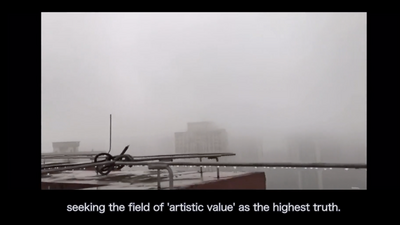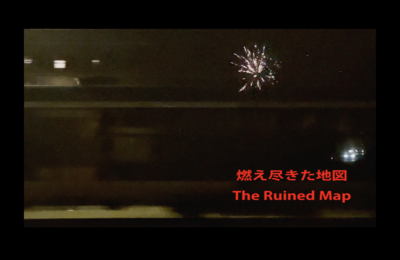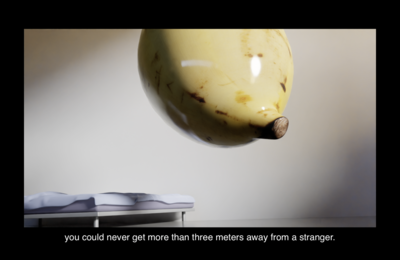Text on Practice Muyang: Difference between revisions
No edit summary |
|||
| Line 55: | Line 55: | ||
— Pedro Neves Marques, ''Parallel futures: One or many dystopias?'' </blockquote>I have been reading Paul Preciado's various texts for three years and it has provided an important guide of revolution to the transitions I have undergone. I have learned from it to combine texts from various genres to get rid of their distribution, to learn to make a flawed (non-binary) work or to bring together my daily notes, theoretical assumptions, complex systems of knowledge, and bodily pain or pleasure: the epistemological transition that is happening to me (the revolution itself). | — Pedro Neves Marques, ''Parallel futures: One or many dystopias?'' </blockquote>I have been reading Paul Preciado's various texts for three years and it has provided an important guide of revolution to the transitions I have undergone. I have learned from it to combine texts from various genres to get rid of their distribution, to learn to make a flawed (non-binary) work or to bring together my daily notes, theoretical assumptions, complex systems of knowledge, and bodily pain or pleasure: the epistemological transition that is happening to me (the revolution itself). | ||
We need to take the step towards a new earthly epistemology. Revolution is an exercise in conjecture, in need of an exercise in cognitive liberation, in Donna Haraway's words, a 'speculative fabrication'. We need to re-imagine. To imagine is to act: to recover imagination as a force for political transformation is already to begin to mutate. | We need to take the step towards a new earthly epistemology. Revolution is an exercise in conjecture, in need of an exercise in cognitive liberation, in Donna Haraway's words, a 'speculative fabrication'. We need to re-imagine. To imagine is to act: to recover imagination as a force for political transformation is already to begin to mutate. Through my writing and art, I hope to find a logic of expressing cosmic forms with somathèque at its center, a logic that emerges in various ancient Chinese texts. I want to rediscover the intimacy of self and environment lost in modernity, to make it possible to think on a planetary scale, and to write about a safe, joyful, and sensual way of dwelling. | ||
My work embraces queer utopia, which is also apocalypse and capitalist ruins. Pedro Neves Marques' essays on toxicity and immunology, the political agency of sex, indigenous futurism and dystopia inspire me a lot and are important references for the work I wanted to make next. | My work embraces queer utopia, which is also apocalypse and capitalist ruins. Pedro Neves Marques' essays on toxicity and immunology, the political agency of sex, indigenous futurism and dystopia inspire me a lot and are important references for the work I wanted to make next. Firstly, through Sinophone studies, I hope to understand how the modern body is constructed in China today and how it pathologizes the queer body. Secondly, I want to reflect on reproductive justice and humans’ entanglement with the nonhuman, how the porous body is closely linked to what Mel Y. Chen calls "the inanimate, deadness, lowness, nonhuman animals (rendered as insensate), the abject, [and] the object," beyond a rigid understanding of desire and humanity. Finally, I will transform defective, queer, porous bodies and practices into apocalyptic narratives, such as humans having sex with plants to survive the end of the world. | ||
Firstly, through Sinophone studies, I hope to understand how the modern body is constructed in China today and how it pathologizes the queer body. Secondly, I want to reflect on reproductive justice and humans’ entanglement with the nonhuman, how the porous body is closely linked to what Mel Y. Chen calls "the inanimate, deadness, lowness, nonhuman animals (rendered as insensate), the abject, [and] the object," beyond a rigid understanding of desire and humanity. Finally, I will transform defective, queer, porous bodies and practices into apocalyptic narratives, such as humans having sex with plants to survive the end of the world. | |||
=== Bibliography === | === Bibliography === | ||
Revision as of 06:41, 7 March 2023
Kiss of Chaos - Text on Practice by Muyang Teng
The real communist question is not “how to produce,” but “how to live.”
— The Invisible Committee, Now
VOUS AVEZ ENTENDU? C’est le son de votre monde en train de s’effondrer, C’est celui du notre qui resurgit.— Armée zapatiste de libération nationale, communiqué du 21 décembre 2012.
Reconstructing the Localization
As a queer born in a period of high speedy urbanization and globalization in China, I have experience living in several typical immigrant cities. Instead of focusing on topics like "first-tier cities" "manufacturing industry's centers", and "surveillance", in my previous works before coming to the Netherlands, I made more efforts to the aspects of the urban-rural fringe and the queer subculture in China. The vitality of these non-mainstream lifestreams is a unique cultural attribute of Asia. Subculture is a mirror, a path, and a way to understand East Asia, which integrates and transforms the mainstream culture and art dominated by the West.
I believe the two survival modes show greater adaptability in China, both displaying some filth and dirt that need to be eradicated, and they are a necessity for the Chinese future as well. The two survival modes are usually maliciously attacked as parasites in the culture: They just demand while not paying out, weaken individuals or social institutions, and lead to chaos. I tried to tap the potential of the parasites, in the words of Michel Serres, to "generate a different order".
Petro-sexo-racial capitalism has constructed an aesthetic: a taste for the toxic and pleasure of destruction. I do not make a binary division between art and life, but try to use the aesthetic system to break the boundary between them, to achieve the redistribution of the sensible (Jacques Rancière). In my art, I wish to use localization as a method to explore the local context (political, cultural, historical, etc.) of my subject's life journey to reconstruct a personal discourse/counter-discourse that does not exist under the mainstream/hegemonic discourse framework, as a way to respond to my own existential anxiety.
Revolution and Apocalypse
My video work An Artist Who Only Participates in Group Exhibitions arouse from the sudden A4 Revolution, the biggest protest in China since 1989. The government's endless Zero-COVID Policy, the accompanying economic downturn, the collusion between the government and the covid-test industry, and many other problems caused the people to raise the A4 blank papers in protest. The strict censorship of the Communist Party led to the people only being able to hold up blank papers in protest.
Two days later, as the mist filled Rotterdam and Chongqing, my friend sent me a video of the mist in Chongqing. The future was uncertain, like raised white paper interrupting our lives. Also, as a non-white queer artist, I came to Rotterdam experiencing a long period of a liminal state of exhaustion, lost in translation and waiting, not only because of the experienced censorship of the Chinese Communist Party but also because of whiteness in the art world. The blank paper is a ghost in our lives and in art, always ignored and linked to the liminal space of unconscious processes of waiting, refusal, and turning, containing an infinite amount of unwritten ghost texts and creative potential (here referring to the ghostly presence in Georges Perec's writing, with its mass of pre-determined, unresolved, wavering and agenda-like remnants of notes).
I got inspired by the spectrum of anarchist thought represented by Tiqqun and The Invisible Committee. The political and intellectual movements they initiated in Europe had a countercultural form that supported insurrection and social organizations that used people and the forces of production to go beyond the means of representative democracy. I fictionalize the blank paper as a parasitic artist who can only participate in group exhibitions (also the sub-medium proposed by Boris Groys), a proletariat in revolt against art capitalism. Using only a misty video of Chongqing sent to me by my friend, I depict a futuristic dystopia in the video: because everything is in ruins, the only way forward is a sort of anarchic return to nature (the blank paper state), on the run from all systems of control.
Searching For A Character Between East and West
The Ruined Map is an experimental film that combines existentialist fiction, 3D animation, and distorted sound waiting in an underground station. Beginning with a Christmas fireworks scene shot on a train, it seems to herald the end of an era and the dawn of a new one. What follows is a ruin, a fragmented narrative, a ruined map...
The Ruined Map is set in the context of my arrival in the Netherlands as a gay Chinese man, where I am confronted not only with the power of structural Western centrism (e.g. the fetishism and sexual racism of white men I suffer on Dutch dating apps), but also the inescapable specter of Chinese-centric oppression (Chinese etiquette and customs, state institutions, moral standards, etc.).
Finding a partner has always been a big part of my life. Each long wait and many fleeting love affairs left me in a peculiar liminal situation and reinforced my strong sense of displacement and dysphoria. When writing the script, I draw on my own experience as a Chinese male who grew up under the influence of Western pornography until he became a pornography translator in Rotterdam, reflecting on what Paul Preciado calls “the orgasmic force” - the labor forces of the pharmacopornographic age. The disobedient body, the queer body responds to the policing of the normative body, and how technology reinforces the construction of masculinity. This body was discriminated against and suffered from dysphoria from cybernetic and pharmacopornographic neoliberalism.
The original text is written in Chinese, Japanese, and English, mingling like the waters of an estuary. Through a surreal, fast-paced, and hauntingly dreamlike narrative and the impossible clues found therein, the transition process from subjective scale to planetary scale is approached in a kind of linguistic chaos and instability.
Banana and twinkie are typical racist everyday Western epithets for East Asians who have lost their heritage. Such antagonized otherness in Western narratives helped manifest the “imagined Western” identification. In my mind, they also represent China’s counterfeit sense of inferiority against the powerful. Then, I associate their images with the stereotypical East Asian small penis. In the animations, bananas and twinkies are converted to “characters” who are repeatedly inflated and deflated. I arrange them in three liminal places: in darkness and mist, suspended over the ocean, and inside the bedroom. They look lonely, desperate, and nervous while giving off a strange and intimate feeling, subverting the stereotypes of East Asia.
Anti-Orientalist Queer Desire and Temporalities
José Muñoz understood queerness as “not yet”, as a “mode of desiring that allows us to see and feel beyond the quagmire of the present.” My “queer” subjects are often absent from my work. Unlike the Western-centered gay art that shows the “progressive essence” of coming out as happy, proud, and glamorous, I choose to show the so-called "backward" histories of “queerness” as sad, dark, and negative. I’m trying to dismantle the structures that oppress me by portraying a character who can only exist in the world as a "loser" (the dysphoria, the neglected blank paper, the impotent male…), expressing the attitude of queer. I try to confront the world of self-oppression by destroying the "self" and freeing it from the social structures of oppression. Transforming the coordinates of change and confrontation is my art strategy, in order to alter the existing normative boundaries.
By using “queer” to define my work, I am neither suggesting that Chinese non-normative expressions of desire and gender are direct and outdated translations of those found and theorized in the Western world, nor am I affirming the nativist response to the homogeneity and cultural imperialism represented by the globalization of queerness. Here, I have been inspired by the Sinophone studies: Wai-Siam Hee's From Amorous Histories to Sexual Histories tells the story of how Chinese male-male sex has moved from a traditional narrative preference for sex art to being marginalized by the nation-state's pathological narrative mechanism of "sexual history" in the name of "sexual science," and how mainstream Western values have brought "homophobia" to China.
Embarking on The Most Beautiful/Destructive Collective Adventure
Une station-service abandonnée est plus belle que le Taj Majal.
— J. G. Ballard, What I believe
... white people have appropriated the ruins of others, as if through this 'assimilation' they might erase colonial differences between themselves and all those they have oppressed.
— Pedro Neves Marques, Parallel futures: One or many dystopias?
I have been reading Paul Preciado's various texts for three years and it has provided an important guide of revolution to the transitions I have undergone. I have learned from it to combine texts from various genres to get rid of their distribution, to learn to make a flawed (non-binary) work or to bring together my daily notes, theoretical assumptions, complex systems of knowledge, and bodily pain or pleasure: the epistemological transition that is happening to me (the revolution itself).
We need to take the step towards a new earthly epistemology. Revolution is an exercise in conjecture, in need of an exercise in cognitive liberation, in Donna Haraway's words, a 'speculative fabrication'. We need to re-imagine. To imagine is to act: to recover imagination as a force for political transformation is already to begin to mutate. Through my writing and art, I hope to find a logic of expressing cosmic forms with somathèque at its center, a logic that emerges in various ancient Chinese texts. I want to rediscover the intimacy of self and environment lost in modernity, to make it possible to think on a planetary scale, and to write about a safe, joyful, and sensual way of dwelling.
My work embraces queer utopia, which is also apocalypse and capitalist ruins. Pedro Neves Marques' essays on toxicity and immunology, the political agency of sex, indigenous futurism and dystopia inspire me a lot and are important references for the work I wanted to make next. Firstly, through Sinophone studies, I hope to understand how the modern body is constructed in China today and how it pathologizes the queer body. Secondly, I want to reflect on reproductive justice and humans’ entanglement with the nonhuman, how the porous body is closely linked to what Mel Y. Chen calls "the inanimate, deadness, lowness, nonhuman animals (rendered as insensate), the abject, [and] the object," beyond a rigid understanding of desire and humanity. Finally, I will transform defective, queer, porous bodies and practices into apocalyptic narratives, such as humans having sex with plants to survive the end of the world.
Bibliography
- Armée zapatiste de libération nationale (2013) Communique du comite clandestin Revolutionnaire Indigene, Commandance Generale de L'ARMEE Zapatiste de Liberation National EZLN. 21 décembre 2012., Enlace Zapatista. Available at: https://enlacezapatista.ezln.org.mx/2013/01/02/communique-du-comite-clandestin-revolutionnaire-indigene-commandance-generale-de-larmee-zapatiste-de-liberation-national-ezln-21-decembre-2012/ (Accessed: March 4, 2023).
- Ballard, J.G. (1984) “What I Believe,” French in Science Fiction #1 [Preprint].
- Braidotti, R. (2019) Posthuman knowledge. Cambridge, UK: Polity Press.
- Chiang, H. (2018) Sexuality in China: Histories of power and pleasure. Seattle, Washington: University of Washington Press.
- Chiang, H. and Heinrich, A.L. (2017) Queer Sinophone Cultures. London: Routledge, Taylor & Francis Group.
- Groys, B. and Strathausen, C. (2012) Under suspicion: A phenomenology of media. New York, NY: Columbia University Press.
- Hee, W.-S. (2015) From Amorous Histories to Sexual Histories: Tongzhi Writings and the Construction of Masculinities in Late Qing and Modern China. Tao yuan shi: Guo li zhong yang da xue chu ban zhong xin.
- The Invisible Committee (2017) Now. South Pasadena, California: Semiotext(e).
- Marques, P.N. (2019) Parallel futures: One or many dystopias? - journal #99 April 2019 - e-flux, e-flux. Available at: https://www.e-flux.com/journal/99/263702/parallel-futures-one-or-many-dystopias/ (Accessed: March 7, 2023).
- Muñoz, J.E. (2009) Cruising utopia: The then and there of Queer Futurity. New York, NY: New York University Press.
- Preciado, P.B. (2017) Testo Junkie: Sex, drugs, and biopolitics in the Pharmacopornographic Era. New York, NY: Feminist Press at the City University of New York.
- Preciado, P.B. (2023) Dysphoria mundi. Paris, France: Grasset.
- Rancière Jacques (2013) The politics of aesthetics: The distribution of the sensible. London, UK: Bloomsbury Academic.
- Serres, M. (2013) The Parasite. Minneapolis, MN: University of Minnesota Press.
- Shih, S.-mei (2007) Visuality and identity: Sinophone articulations across the Pacific. Berkeley, CA: University of California Press.



